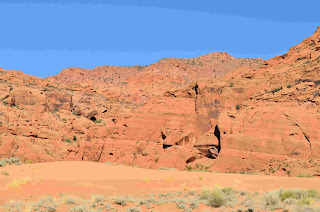We went into Cheyenne one day while here (25 mile approx.) In Cheyenne we saw the State Capitol, the Governor's mansion, the State museum, the historic train depot and also had an excellent meal at Mitchell's BBQ. As we travel, note that we will only mention those really memorable meals (the ones that really stand out that we will return to). Wow, Mitchell's really met this criteria. Bob had the BBQ slider sample and Teri had the fried catfish. All those years in Lake Charles LA, and nothing there came even close.
While in Wyoming we learned some interesting facts.
- Sep 30, 1889: Wyoming grants women the right to vote, wow 30 years before the ratification of the 19th amendment! (now we did not know that).
- Yellowstone (In Wyoming) is the first official National Park (1872)
- Wyoming was the first State to Have a County Public Library System
- The JCPenney stores were started in Kemmerer, Wy.
- The first Dude Ranch in Wyoming was the Eaton Ranch, near Wolf. The Eaton's also came up with the term "dude".
- Wyoming has the lowest population of all 50 United States.
- The white tiles are Italian marble and the black tiles are from Vermont and in many of the black tiles you will see fossils.
- The ceilings for both House and Senate chambers are inlaid with beautiful Tiffany-style glass and the Wyoming State Seal is prominently displayed in the center.
- In 1904, Wyoming built its first governor’s mansion. It was a modest house compared to the pretentious dwellings built in other parts of downtown Cheyenne and was built in the middle of a middle class neighborhood.
- The mansion was the residence of 19 Wyoming first families from 1905 - 1976.
- . The depot was completed in 1887.
- The depot plaza hosts a variety of music and events throughout the year.
- Constructed in 1888 as offices and a tearoom, the Atlas Building was converted to a theatre in 1908.
- The eight foot tall cowboy boots have been carefully painted by local artists.
- There are a total of 19 displayed throughout the city.
On to Sioux Falls, South Dakota. We should be there on 7/28/13.



























































